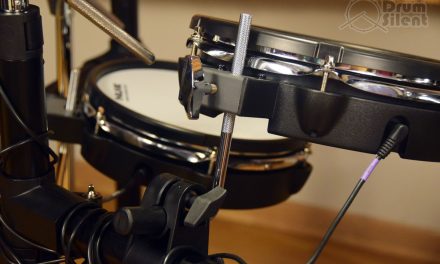When it comes to electronic drum kits, certain types of headphones will work better than other. Headphones that provide good comfort, noise isolation and long cables tend to provide a better electronic drumming experience. Let’s take a closer look at the type of headphones you’ll need for electronic drums.
Comfort For Longer Drumming Sessions
The first point we’d like to touch on is comfort. This can involve a few different aspects.
There are some questions you can ask yourself if you are trying out some headphones to see how they feel. How well do the headphones sit on your head? Do they feel snug, too loose or too tight? How does the headband feel on the top of your head? Do they have any hot spots that cause discomfort more quickly? Are the ear cups large enough or deep enough to fit over your ears?
Personally, when I’m drumming, I prefer a snug fit to my headphones so that they stay on my head while I’m moving around. A more snug fit can also aid in better noise isolation if the ear cups create a good seal around your ears.
Another thing to think about is warmth while wearing the headphones. Drumming is an activity that gets the blood flowing and headphones that retain too much heat in the ear cups could be uncomfortable if your practice space is more warm or humid.
Closed Back, Over Ear Design
The best types of headphones for electronic drumming are usually the types of headphones with closed back, over ear design. What this means is that the ear cups fit all the way over your ear and provide some amount of passive noise isolation.
This will help you focus more on the sounds coming from the drum module and less on the drum sticks tapping on the pads, which can help greatly with immersion when jamming on an electronic drum kit.
Try to avoid open back headphones or headphones that don’t provide much of a seal with ear cups around your ears. They can work fine if it’s all you have, but you’ll get less noise isolation and will hear more of the sticks on the drum pads.
Longer, Straight Cables Are Better
Look for headphones that have longer, straight cables and try to avoid headphones that have the shorter, coiled cables. The longer, straight cables are easier to keep out of the way while you are playing drums and they will give you some leeway if you need to stand up and move around your kit without taking your headphones off. Try to find headphones with 10 foot or longer cables. This is a pretty common cable length for studio headphones but consumer level headphones often have shorter cables.
Shorter cables will get in the way more easily since you might not be able to drape them over your shoulder or behind you to keep them out of the way. It can also be easier to stress or damage the headphone outputs if you yank on a shorter cable accidentally while moving around.
If all you have is headphones with shorter cables, you can always get a headphone extension cord to give yourself some more cable length.
Studio Quality Sound
I prefer to lean more into studio headphones than consumer level headphones for electronic drumming. While the terms might be a bit subjective, a good pair of studio headphones is going to provide a more balanced sound overall that can work great for hearing the intricacies of a drum kit.
On the flip side, consumer level headphones tend to color the sound, push more bass and treble and tame the mid range. That can sound good with some music, but it might not sound as good when plugged into a drum module.
However, sound preferences are completely subjective and if you like the way a certain pair of headphones sounds with your kit, that’s all that matters at the end of the day.
Image courtesy of Reference Audio Analyzer
Headphone Recommendations for Electronic Drumming
We have reviewed quite a few different headphones to see how they feel and sound. We also try them out with electronic drum kits to see how they specifically will work for electronic drummers. Check out our studio headphone reviews for more, or check out our picks for the best headphones for electronic drummers for specific recommendations.










